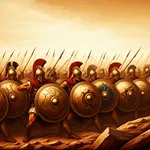Historical accuracy of 300

Historical accuracy of 300

Characters
King Leonidas
Leonidas was a real king, but the film's portrayal is highly stylized and exaggerated, more graphic novel than history.
Queen Gorgo
Gorgo was a real queen. The film amplifies her role; historically, her influence was likely more subtle.
Xerxes
Xerxes is portrayed as an androgynous, almost monstrous figure. Historical accounts describe him as a typical Persian king.
Ephialtes
Ephialtes was real, but his film portrayal as deformed and motivated by rejection is fictionalized; his actual motives are debated.
Dilios
Dilios was a real warrior. The film exaggerates his role and personality; his single eye is from historical accounts.
The Ephors
The Ephors were powerful Spartan officials, but the film exaggerates their grotesque appearance and corrupt nature.
More characters
Immortals as supernatural warriors
The Immortals were an elite Persian unit, but they were not superhuman or magically imbued. The film's depiction is purely fictional.
Story
300 Spartans fought alone
While 300 Spartans were present, they were accompanied by thousands of other Greek allies. The film significantly downplays the contribution of these other forces.
Ephialtes' betrayal
Ephialtes, a local shepherd, did betray the Greeks by revealing a hidden path to the Persians.
Leonidas' defiance of Xerxes
While the dialogue is fictionalized, Leonidas likely refused to surrender to Xerxes.
Spartans' motivation for fighting
While defending Greece was a factor, Spartans were also motivated by upholding their honor and reputation.
Battle tactics and formations
The film depicts the phalanx formation and use of spears, but the scale and choreography of the battles are exaggerated for cinematic effect.
Use of 'This is Sparta!'
While Spartans were known for their laconic speech, there's no historical evidence Leonidas ever uttered 'This is Sparta!'.
Setting
Spartan society depicted
The film captures the warrior culture and emphasis on discipline, but exaggerates the brutality and xenophobia of Spartan society.
Persian army's diversity
The Persian army was diverse, but the film's portrayal includes fantastical creatures and exaggerates the 'exotic' nature of the forces.
Depiction of the Hot Gates
The film accurately portrays the narrow pass at Thermopylae, which was crucial to the Greek strategy.
Overall
Overall historical accuracy
While based on a real event, '300' takes significant liberties with history for dramatic and visual effect. It's more a work of fantasy than a historical account.
The real history behind 300
The Battle of Thermopylae

The Battle of Thermopylae, 480 BC, stands as a symbol of heroic defiance. A small Greek force, led by King Leonidas of Sparta, held a narrow pass against the massive Persian army. For three days, the Greeks fought fiercely, inflicting heavy casualties.
Despite being vastly outnumbered, their strategic position and superior tactics proved effective. A traitor's betrayal revealed a bypass, allowing the Persians to flank the Greeks. Leonidas, knowing defeat was inevitable, dismissed most of his army, remaining with 300 Spartans and other loyal soldiers. They fought to the last man, their sacrifice delaying the Persian advance and inspiring future generations.
